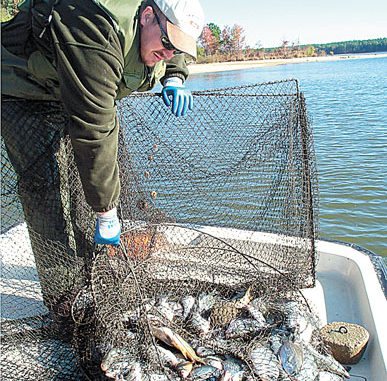
The weather is frigid. The crappie are beautiful. The fishing is great. Let’s go!
If you happened to stop by Stokes McClellan’s home in February, chances are, you won’t find him at home. While most fishermen who target crappie are getting ready for spring — re-lining reels, inspecting their stores of crappie jigs and cleaning out their minnow buckets — McClellan is fishing.
A native of Huntersville, McClellan often wonders if there is an “offseason” for crappie, one of America’s most beloved gamefish. If there is, he figures, it isn’t the winter.
McClellan may not be chomping at the bit to get on the water at first light, but from late January through February, he says loads of crappie are there for the catching, plus there’s much less competition for them than in a couple of months when the dogwoods start to bloom.
In fact, as a board member and long standing competitor on the Southern Crappie Tournament Trail, McClellan and most of his colleagues plan their tournament schedule to run through the winter because they catch more and better fish.
To the casual observer, crappie fishermen who are trolling all look alike. Each boat comes equipped with rod holders and a trolling motor, and when fishing, looks like a 20-foot water bug scooting across the water with long spindly legs pointing out in all directions. To sum up crappie trolling in a nutshell, it comes down to one of two things. You’re either pushin’or pullin’.
Pushin’— more commonly known as “tight-lining” — is a slow-trolling technique in which lines are kept mostly on the front and sides of the boat, fishing vertically at a precise depth. The boat eases around and over the top of underwater structure.
Pullin’is a faster tactic and more akin to what most people think of as trolling. In long-line trolling, single or double jigs are cast behind the boat and trolled to the rear. Speed, weight of the bait and the amount of line out all combine to determine the depth you fish. Achieving the proper depth of presentation is often the difference between catching fish and just freezing your tail off.
McClellan and his tournament partner, Frank Carpenter, long-line troll at all three of their favorite winter crappie lakes. What’s unusual is that the key depths are not the same.
Lake Wylie
At the top of the list of winter hotspots is Wylie, which lies along the North Carolina-South Carolina border southwest of Charlotte. McClellan said Lake Wylie crappie suspend in the water column while it’s cold. He and Carpenter often find them within six feet of the surface in more than 40 feet of water, and that’s why they long line for them.
“I can troll Wylie even when the water is down as low as 48 or 49 degrees,” McClellan said. “Below the Buster Boyd bridge, the Catawba River makes a huge bend right there in front of Crowder’s Creek. We find crappie suspended over that bend from five to seven feet below the surface.”
To get down to the fish, the team trolls 1/32nd-ounce jigheads 60 to 70 feet behind their boat. All their long-line trolling is done with 4-pound test line. It’s a consistent factor in how deep the jigs will go. Although McClellan’s average trolling speed is 1.1 to 1.5 miles per hour, he’ll slow down to .7 – .9 to achieve the right depth. He said that almost any color will work on Wylie as long as it’s in the green family. His favorite is a watermelon/red metal flake. He pairs these with orange jigheads that Wylie crappie seem to prefer as well.
Another favored spot on Wylie is where the mouth of Big Allison and Little Allison Creeks meet.
“The thermal discharge is located in the back of the creek, but it doesn’t have that much effect out in the mouth,” McClellan said. “It does draw a lot of bait, and the water may be a few degrees warmer, but they also don’t seem to run as much water through it when it’s cold. I’ve never caught anything but small fish closer to the discharge, where the water is 10 degrees warmer than the rest of the lake.”
“The whole lake is loaded with bait,” said Carpenter, who lives on the lake in Belmont. “You don’t see the winter die-offs of shad in Wylie like you do in other lakes. That’s one of the reasons we love to fish here.”
Jordan Lake
Similar to Wylie, McClellan and Carpenter credit superior numbers of baitfish with their success on Jordan, which is is known for big fish. The cold-weather, prespawn pattern is the time to catch them.
“I do a fair amount of striper fishing, and you’d be surprised how big a shad a crappie will eat,” Carpenter said. “Jordan has a bunch of threadfin and gizzard shad, and some of the gizzards get to be pretty good size. I guess if I was hungry and had a choice between chasing down 15 Cheese-Its or one big cheese sandwich, I’d go for the sandwich, too.”
McClellan said that Jordan crappie hold deeper during the winter than those at Wylie. He attributes that to their relation to the edge of the New Hope River channel that extends above the US 64 bridge.
“As you go up the lake from the bridge toward Farrington Point landing, there are ledges that come off the main-river channel,” McClellan said. “When you troll down the edge of the main channel, you’re crossing a series of ups and downs on the bottom where those ledges come into the channel. We catch most of our crappie over the tops of those high spots, suspended off the bottom about 15 to 17 feet down.”
Their recipe for long-lining at Jordan is fishing eighth-ounce jigs fished 90 feet behind the boat. At a speed of .7 miles per hour — the slowest McClellan said he can run and still make any kind of plastic swim — he can reach winter crappie on those high spots. The main channel along a 2-mile stretch between the bridge and No Name Creek is his best run to troll either Bass Pro Triple Ripple grubs in Tennessee shad colors or Charlie Brewer Slider grubs in John Deere green.
Another good trolling run on Jordan is No Name Creek, where the ledges extend into the standing timber. McClellan and Carpenter troll between the main channel and the standing timber nearly all the way up to Farrington and Bush Creek.
High Rock Lake
The stereotypes for crappie lakes in North Carolina are Jordan for size and High Rock for numbers. Carpenter thinks it’s time to change the stereotype for High Rock.
“We used to hardly ever catch a 2-pound fish on High Rock,” he said. “We caught a lot of tater chips and had to weed through them to find any good fish, but that’s really been changing over the last couple of years. Now, we catch at least one 2-pounder and maybe a few more every trip to High Rock, and even the average size of the tater chips is getting bigger.”
McClellan and Carpenter troll with 1/16th-ounce jigs, and to reach crappie that generally suspend in the 8- to 10-foot range around the mouth of major tributaries. They run their jigs about 75 yards behind the boat and troll just under 1.0 mph. Top locations on their list at High Rock are Second, Panther and Flat Swamp creeks.
“High Rock will be the most-stained lake of the three,” said McClellan. “For that reason, it will stay a little warmer and is likely to be in the 53- to 55-degree range during February. My best stained-water colors are combinations of black and blue, junebug/chartreuse and red/chartreuse. I also like to use a red-headed jighead for these situations.”
Two additional factors that deserve discussion in their long-line trolling arsenal are rod and line choices. McClellan runs eight rods from the rear of his boat, with the shortest ones next to the motor and growing longer as they are split apart. B’n’M Sam’s Sensitive rods in 9-, 10-, and 12-foot lengths occupy the first three spots, while a 14-foot Pro Staff trolling rod flanks them on each side. All of this specially tailored gear is tied to the fish by only 4-pound test. McClellan defends his choice of line.
“I know all my boat speed, jig weight, and line out ratios based on 4-pound test line,” he said. “Trust me, 4-pound test can handle big fish. My record is a 27½-pound flathead catfish we caught at High Rock a few years ago. We’ve also caught a number of stripers 15 pounds or better.
“A properly-set drag and a long, limber rod will absorb a lot of pressure and keep you from breaking off. One of the things I discuss in the seminars I give is to be consistent. If you’re not comfortable with 4-, then go to 6-, but don’t mix lines. That will definitely mess things up in terms of crossed lines and incorrect depth.

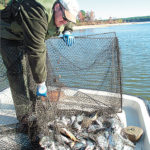
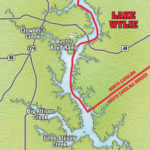
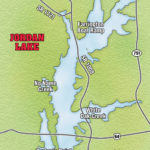
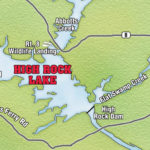
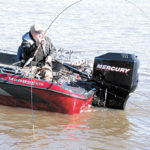
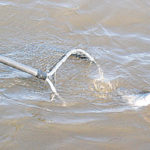
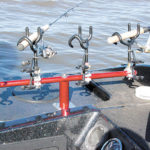
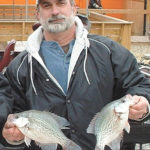



Be the first to comment